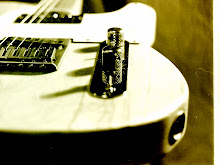Bill Frisell’s current trio with Eyvind Kang and Rudy Royston goes by the name Beautiful Dreamers, after their eponymous album of last year. It’s an apt moniker for the majestic tapestry of transportive music the trio weaves.
With Kang on violin and Royston on drums, the soft-spoken bespectacled guitarist again graced the stage of Narrows Center in Fall River, Mass., last night. Like last year’s show there (see my write up of that concert here), it was a magnificent palette of colorful sounds and musical interplay.
What this trio does is a jazzy take on Americana, flavored with modern effects and occasional new-agey elements – all rendered with impeccable musicianship. If not for Frisell’s clear country and folk influences, and his notable propensity for twiddling the knobs of his various stomp-box effects, it would be easy to label him a “jazz guitarist.” And most do. But that charts too narrow a course for his wide-ranging, intuitive and, ultimately, joyous musical explorations. Yes, there are plenty of modal chords in the mix, and the complex melodies he and Kang play in unison are straight out of the jazz playbook. But Frisell’s sonic sparring with delay and other effects puts him in another place than most jazzers dwell. It’s not quite The Edge or Robin Trower (re: the effects) meets Chet Atkins and Les Paul, but it is something akin to that – though clearly with more emphasis on the latter two six-string icons.
With steady concentration, Frisell and co. build a mounting swirl of sound that expands and then ambles onward as it evolves. The guitarist barely breaks a sweat – you won’t see any rock star posing or facial contorting (other than the occasional gleeful smile aimed at a bandmate after a particularly inspired passage). Yet, when the moment is right, he can seriously rip it up. Even then, though, he does it with precision and control, looking at his instrument with a studied thoughtfulness.
That’s not to suggest any lack of passion or feeling in his playing. In fact, it’s exactly the opposite! His fingers effortlessly feel out the most emotive melodies and chord patterns, often infused with a joy that borders on giddiness. This is most evident in the trio’s jaunty take on the Carter Family classic, “Keep on the Sunny Side,” which seems to be emerging as one of the several standards that Frisell is often associated with (along with his unique renditions of “Heard It Through the Grapevine,” “Shenandoah” and a few others). So while his particular brand of flare on the instrument may be understated, it’s no less impactful.
Of those nods to past country and r&b classics, only “Sunny Side,” was featured in Saturday’s two-set, 100-minute performance. But it was a standout along with “Tea for Two,” “Hard Times” and a stunning encore of “Goin’ Out of My Head.”

I love the interplay between Frisell and Kang (interesting and creative violin playing always gets me, too). Kang has a nuanced feel for a variety of styles, and he’s more than just an adept counterpart for Frisell, mirroring the guitarist’s jazzy licks. On many songs, it’s Kang who leads the way, with Frisell providing the supportive reflections and foundation. Last night reminded me why I was so impressed by Kang last year. But this time I was even more struck by his stunning pizzicato string work. I don’t recall ever seeing a violinist finger pick the strings as much or as adeptly as Kang.
The dynamic that Royston’s super-subtle percussive touch brings to the group is unparalleled. This time around, I had a different vantage point on the triangulated trio, and thus a much better view of the drummer’s surgical stick work (his light dexterity on the cymbals was extraordinary). Royston’s playing is, most of the time, fittingly low key, but every once in a while he executes a controlled explosion, as if to say, “Yeah, I can do that, too!”
In the end, however, as much as Frisell would probably like to make it otherwise, it really is primarily about the guitarist. Playing a red Fender Stratocaster, rather than his familiar Telecaster, he let his musical comrades shine, but left no doubt as to why he was the focal point of the affair. I can’t wait for the next time around.





No comments:
Post a Comment